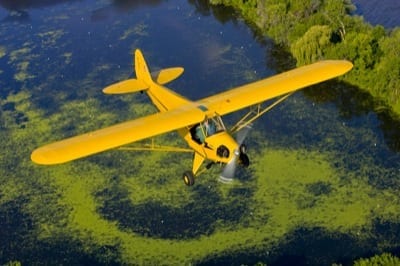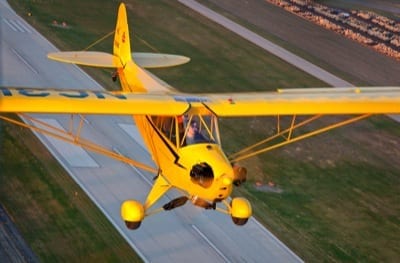As a student pilot flying a Piper J-3 Cub, on any beautiful Sunday afternoon it was not unusual to be 8th to 10th on downwind at Zahn’s Airport at Amityville on New York’s Long Island.
The year was 1954. Finally, I was able to take flying lessons, having been transferred from my position on a newspaper in San Francisco to New York City, working for publications owned by the Hearst Corporation.
This was at the height of the general aviation flying boom following World War II. Zahn’s Airport had more than 200 based airplanes and helicopters, ranging from corporate twins and the latest single-engines to those bright yellow and black J-3 Cubs. There were at least seven J-3s in the training fleet and scheduled time for them had to be made far in advance for weekend training.

The strip had been cut out of an apple orchard in the late 1930s by Joseph Zahn, the owner who, along with his friend Jack Looney, flew a Cub from the grass field until the war curtailed many activities. After the war, flight instructor Ed Lyons was determined to teach flying and he, along with Zahn, Looney, and Walter Hoffman, started Zahn’s Airport.
In 1951, Roosevelt Field — where Lindbergh started his flight to Paris — closed and Zahn’s became the busiest general aviation airport in New York State.
There was no control tower. On those beautiful Sunday afternoons Walter Hoffman would sit beside the approach end of the 4,200-foot asphalt runway with a light gun and flash pilots either green to land or red to make a go-around and try again. Students learned much about busy traffic areas.
My first lesson was on May 31, 1954, in J-3 Cub N2038M. A lesson in the J-3 cost $10 an hour, $3 for the instructor and $7 for that beautiful Piper. For solos, and later rentals to take friends or family members for a flight, the cost was $7 an hour.
Sitting in the back seat of the tandem-seat Cub provided the opportunity to “get the feel” of the airplane. With big instructors occupying the front seat, it often proved difficult to see the five basic instruments on the panel. Estimating air speed was by guess and lucky glimpses at the panel.
We did three-point landings, wheel landings, go-arounds, aborted takeoffs. For crosswind landings there was an east-west runway. At that time, part of it was asphalt and the other portion dirt. Where the two met, the asphalt was almost a foot higher than the dirt section, meaning when landing to the west if we were on the ground before the end of dirt we practiced giving power to lift over the step and get up on the asphalt.
After seven and a fraction hours of this training in different J-3s, the instructor got out, warned me to be careful because the airplane would be lighter, and said “take it around and if I don’t flag you down, do it a few more times before you come in.”
The first solo cross-country was a cinch. I took the Cub to the eastern end of Long Island and back. There was ocean on one side and Long Island Sound on the other. As long as I stayed over land, there was no way to get lost.
Other solo cross-country flights were not so simple for a novice to navigate. They were directly over New York City to New Jersey airports. And what a beautiful sight it was at 2,500 or 3,500 feet, putt-putting along directly over Queens and Brooklyn and seeing Central Park laid out in the center of Manhattan. Over Queens I saw LaGuardia to the north and Idlewild International (now JFK) to the south.
There was no radio in the Cub. No transponder. No GPS. No terminal control areas of Class B airspace. Just pleasant flying.

There are a few more airplanes today than back then but speeds are no faster. Speed restrictions below 18,000 feet today are the same as the top speeds of Douglas, Boeing, Lockheed, Convair, and other transport carriers of the day when I in the Cub enjoyed my training flights over New York City.
The long cross-country flight in the J-3 was again back over New York City, across the Hudson River and South in New Jersey to Atlantic City. When asking the airport manager to sign my logbook to attest to the fact that I did make the flight, he said he had a small request. “On your takeoff, he said, would you mind using a runway? You landed on a taxiway.” How was I to know? It was directly into the wind, as wide and almost as long as the runway at Zahn’s.
After 46 hours and 50 minutes of training and solo flying, my instructors considered me ready for a flight test. I had aced my FAA written examination by correctly answering 49 out of 50 true-or-false questions. Ed Lyons, in addition to being part owner of the airport and flight instructor, was also a flight examiner. With Lyons in the front seat I proudly took the J-3 into the air and over Long Island and did steep turns, slow flight, and stall recoveries.
Then, Lyons said “spin it.” At least four times I tried. But each time I recovered from the stall instead of dropping the nose to begin a spin. “Give it to me,” Lyons growled and quickly we were looking down to the earth and spinning. “Now, get us out of this,” he yelled. With spinning stopped and once again in level flight we headed back to Zahn’s and I was a private pilot.
Proudly, I took family and friends flying — one at a time — in rented J-3s. But as I added more hours, gained an instrument rating, and found more ways to use aircraft, I moved to Tri-Pacers, Comanches, Mooneys, Bonanzas, Aztecs, Senecas, Cessna 310s, Barons. They were all enjoyable and productive. But, for pure enjoyment there was nothing quite like those hours in those yellow and black Piper J-3 Cubs.
Thank you, Mr. Piper.

Hi,
Could you please inform me where one can enjoy Joy rides in a Piper J-3 cub around San Francisco ?
Regards
Deepak